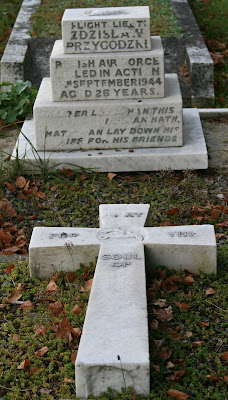Visit any churchyard in Kent and you will find the neatly tended graves of service personnel, not only from Britain but Canada, South Africa, Australia, New Zealand and other far flung corners of the former British Empire.
Here are the stories behind two of those many thousands, both buried in foreign fields.

The memorial at St Peter & St Paul church in Farningham includes the name of my great uncle William Wansbury.
He was born in Kent in 1919 and joined the RAF in 1938, eventually progressing to the rank of Aircraftman 1st Class (ground crew).
In February 1942 RAF personnel, including William, were sent to assist in the defence of the Dutch East Indies which were being invaded by the Japanese.
The combined Dutch, British and Australian forces on Java were not able to withstand the ferocious Japanese onslaught.
On 8th March 1942, William was taken prisoner.
In April 1943 a contingent of around 2000 "fit and healthy" British and Australian POW's were shipped in inhumane conditions to a small coral island called Haruku in the Moluccas.
Those who had not died during the long voyage from Java were immediately set to work building an airfield which the Japanese intended to use as a base for bomber missions against Australia.
Using only primitive hand tools the prisoners were forced to break coral all day long in an attempt to level the ground for the runway whilst enduring continual maltreatment from the brutal Japanese guards.
Tropical diseases including dysentery, malaria and beri beri were rife in the camp and claimed the lives of over 400 men in the space of a few short months.
William succumbed to malnutrition and disease on 14th September 1943 aged just 23.
He is buried on the neighbouring island of Ambon with nearly 2000 further victims of the Japanese war crimes in a cemetery immaculately maintained by the Commonwealth War Graves Commission.

Flight Lieutenant Zdzislaw Henryk Przygodzki is buried in Watling Street Cemetery in Dartford.
He was born on 12th July 1918 and flew with 316 "City of Warsaw" Polish fighter squadron which was formed in 1941.
Several Polish squadrons were formed during the Second World War and they fought with distinction during the Battle of Britain.
On 8th September 1944, Flight Lieutenant Przygodzki took off from RAF Coltishall in his North American Mustang III fighter FB345, possibly on a mission to intercept incoming V1 rockets.
Due to bad weather he was forced to return to base and for unexplained reasons his aircraft crash landed near Bayfield Hall in Norfolk.
I have not been able to find out so far why Flight Lieutenant Przygodzki was buried in Kent and not nearer to the crash site in Norfolk.
The grave is sadly in neglected state at the moment. There is, however, a chance that this situation may be rectified.
I recently sent a copy of my photograph of Flight Lieutenant Przygodzki's grave to the founder of a web site called Polish War Graves. The web site commemorates many thousands of Polish servicemen laid to rest in the UK and other European countries.
He was in contact with a member of the Polish Government and brought up the condition of Flight Lieutenant Przygodski's grave and was given an assurance that "something would be done about it".
Only time will tell whether a Polish politician is any better than a British one, at keeping his word!
If you would like to leave a comment, please do so, they are always very welcome.
Further reading from the archives...
The White Cross of Shoreham
The Hurricane and Spitfire Memorial
Remembering "The Few" in Kent





